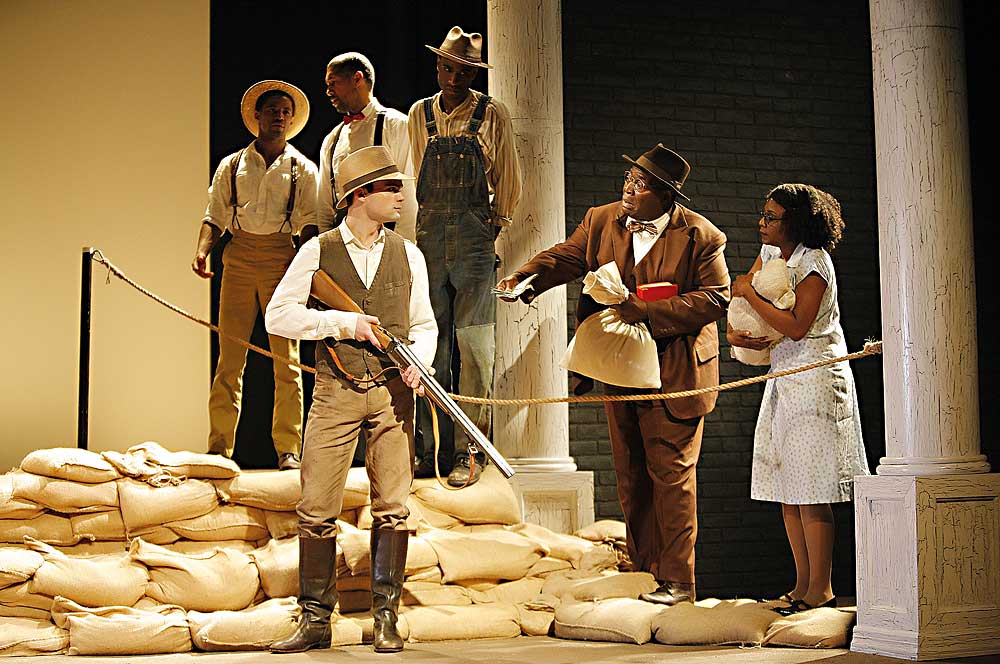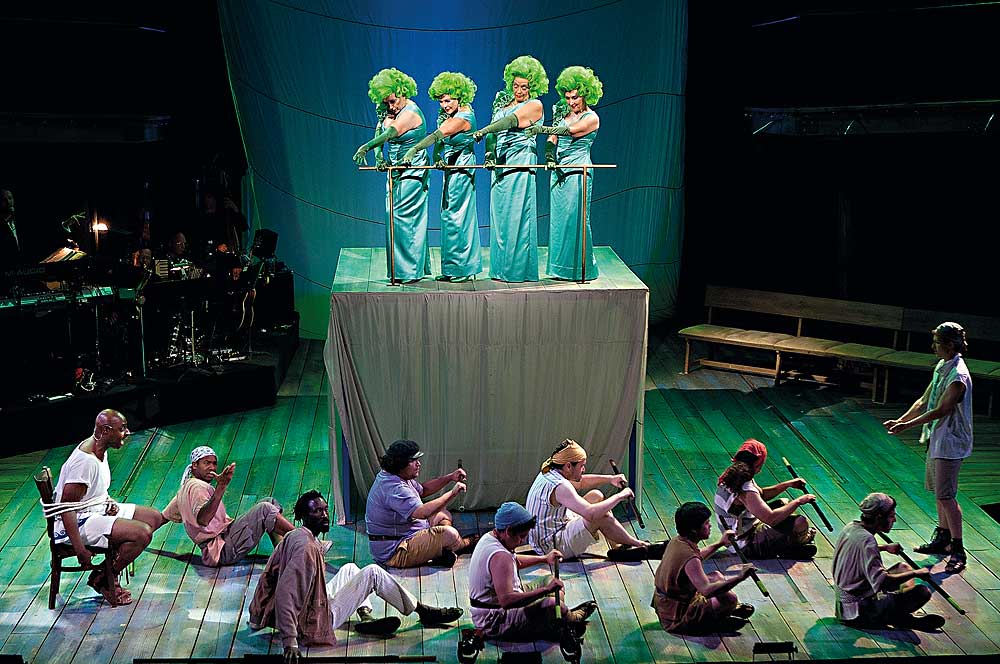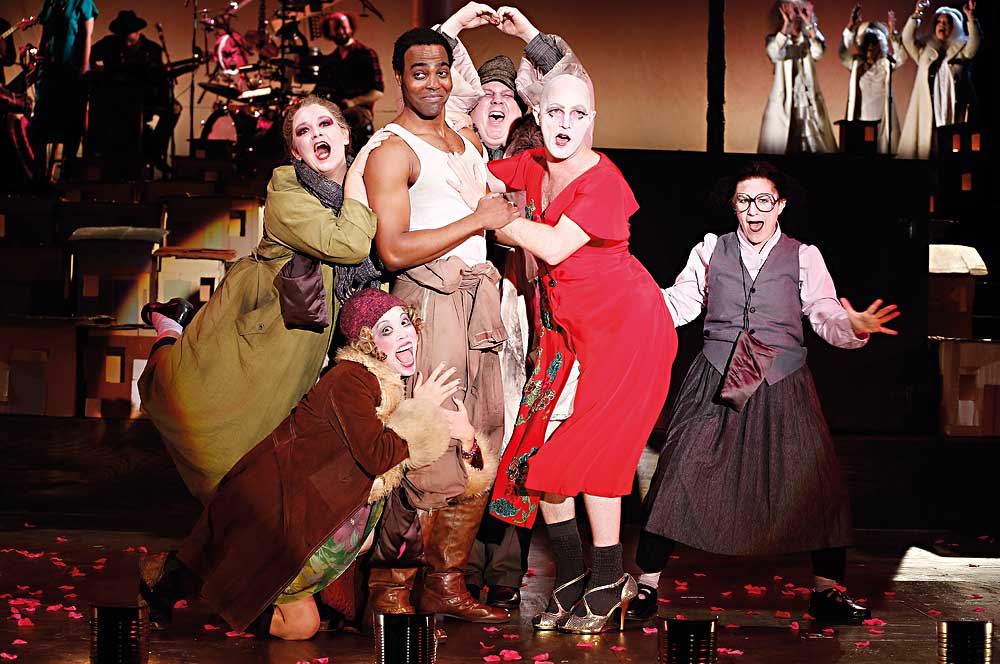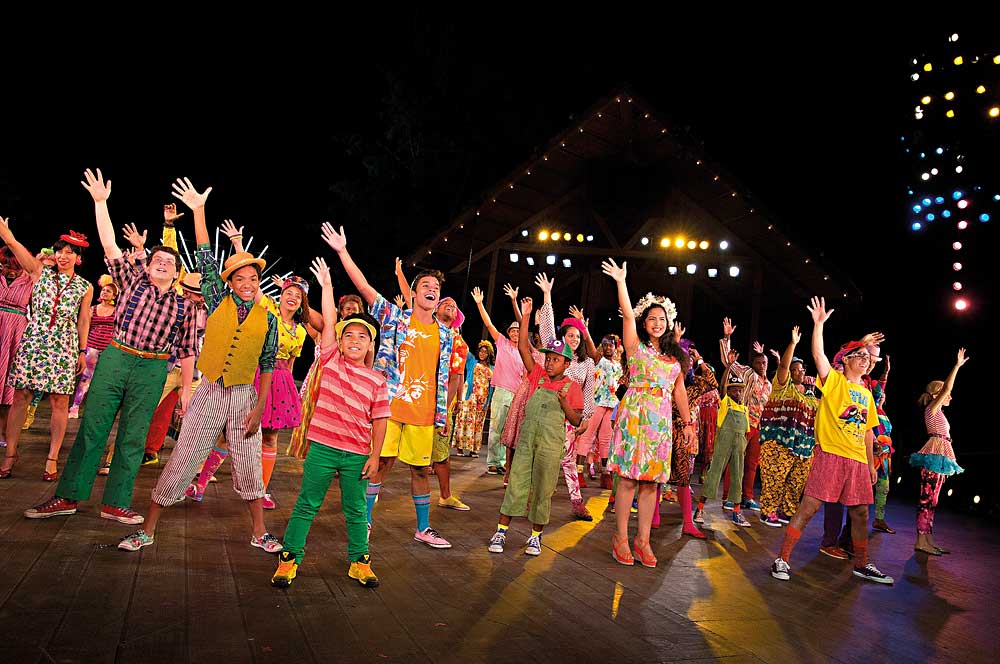
After Quixote, though, she had a moment of doubt—not about the show (“I knew that was what I was born to do,” she avows), but about what the logical next step would be. Separately, she had begun working with Todd Almond, a gifted composer and musical-theatre writer whose work as a music director she had seen in a semi-legendary version of Hair, staged by Theater Mitu at NYU in 2006. Their connection almost didn’t happen: Almond concedes that “when she called, I blew her off for a while. But Lear is incredibly persistent, so I relented. I remember,” he laughs, “I was getting dressed for our coffee and thinking, ‘Only give her 15 minutes!’ And then after two minutes, I sat up straight…and fixed my hair…and got a glimpse of what was sitting across the table from me.”
Their initial collaboration was On the Levee, a Marcus Gardley–penned musical about a horrific series of racism-enabled disasters during the great flood of 1927 in Greenville, Miss. The pair loved working together. As Almond puts it, “We don’t share all the same larger goals, which is almost a help. We complement each other—when she steps forward, I step back.” When San Diego’s Old Globe Theater commissioned deBessonet to create a piece about its community, she shrank from making something bleak about urban decay. Instead, she met as many San Diegans as she could and started building relationships between the theatre and local arts organizations. The Old Globe’s gorgeous open-air venue is housed in old World’s Fair structures, which inspired her to look for stories that encompass the whole world, and to seek out ways to contain many worlds in one. Thus was born her and Almond’s epic version of The Odyssey (see AT’s Jan. ’12 issue “Strategies” column, “Journey to a New World”).
With Quixote, deBessonet had figured out a crucial first ingredient: the intermixing of actors and non-actors from all walks of life. With The Odyssey, though, she uncovered a sturdy scaffolding for the civic drama of which she’s now champion and chief revivalist. She and Almond wound up with a pageant form that required 181 people—much to the Old Globe’s shock and (slightly terrified) delight—by imitating the structure of a parade.

As they debated how to evoke the different worlds Odysseus visits on his long, long voyage home, deBessonet and Almond hit upon a question: What if, instead of a million costume changes, they simply found the perfect people to “be” that world? For instance, Culture Shock, a local hip-hop crew, could play the “super-athletic Phaeacians,” because they were already better athletes than any professional actors the artistic team could train. Each opportunity for spectacle, they decided, could be solved separately and on its own terms: A local gospel choir would play Athena, and—in the sweetest, darkest evocation of Death I’ve seen—a swarm of moon-faced eight-year-olds from San Diego Junior Theatre became the Underworld. Our shades, apparently, are our more innocent selves.
The team also discovered a way to further exploit Almond’s talents. At first, there were no plans to have him onstage, but the creators were getting worried about the sheer traffic control of the thing. Recalls Almond, “We kept asking, ‘What if everything goes wrong?!’ which led us to, ‘What if I were up there conducting? I could say a few things.’ And suddenly the idea turned into, ‘Oh, you’re a narrator!’” In short order, Almond became a dapper, charming emcee, breaking the ancient mood by chatting informally with the audience. It somehow made all the disparate elements cohere—by the logic of vaudeville, perhaps.
By show’s end, the razzle-dazzle was subsumed in almost tangible waves of love from the audience. It was as though Oberammergau had traded in the Christ story for a modern take on a classic text: Almond and deBessonet had reinvented the secular passion play.
Did this new approach result in an amplified poetics elsewhere in deBessonet’s work? Certainly 2013’s Good Person at La MaMa (produced by the Foundry Theatre at La MaMa, and later remounted at the Public) was tight and crisp as a military drum, and it too had an adorable child, a profusion of styles, a sense of joyful uplift and a fairytale quality. Adam Feldman at Time Out New York said, “In Brecht’s rigorously topsy-turvy catechism, goodness in a vicious world is impossible—or rather, it can only be achieved by a kind of theatrical magic…just what this charmingly pointed parable delivers.”

At La MaMa, the audience was seated where people typically place the stage, so that they looked back at risers, marching upward in the lofty wooden space; on them stood little cardboard houses in clusters; far up right there was a space for the band, Cesar Alvarez’s the Lisps, who contributed ecstatic, folk-y songs to the proceedings.
The play’s star actor, the drag artist-musician-performer Taylor Mac, did shattering work as Shen Te, seeming earnest and vulnerable as the woman too good to succeed in a wicked world, then somehow even more vulnerable as Shen Te’s alter-ego, her ruthless male “cousin” Shui Ta. Among the ensemble, there was a sense of something very delicate but very strong; they might have been children who’d been left to invent a game in a room. Says Mac, “Lear has a very clear vision about what she wants. But in the rehearsal room, she asks the actors to bring a great deal to the table—she doesn’t leave them alone, necessarily, but she leaves room for their input, then she edits. She lets us play.” Mac’s plaintive voice, Pierrot-like innocence and long history of New Drag performance became the creative heart of the work, which borrowed his complex pastiche sensibility to both lighten and darken the play.
“My ultimate compass is unearthing the ‘substructure’ of any work, its deep genre,” deBessonet says. “What does the piece want to be? I learned this term from Bartlett Sher, who I assisted when he directed The Barber of Seville at the Met. I tell him it’s the greatest tool he ever gave me. Looking for substructure forces an act of deep listening, which then allows the design, casting and cutting decisions to focus on that DNA, to reveal it.”
In the case of Good Person, the substructure turned out to be commedia and clowning. Hence Matt Saunders’s set. “It’s a poor urban environment, but it has to be a fable, it has to be magical. We see it as a child would imagine a poor village, or perhaps as the gods see us.”
DeBessonet insists that Brecht wove this playfulness into Good Person’s weft: “He was an entertainer! He loved musical comedy, he loved Charlie Chaplin. What you want is a sense of joy that loosens you up so much that you can be knocked off balance by the spiritual emergency of the play.”
While making Good Person, deBessonet was simultaneously gearing up for another 200-person pageant, this one the first Public Works production: The Tempest. She and Almond were collaborating on a to-the-bone edit of the play (it needed to run just 90 minutes), and Almond was composing songs and writing banter at a terrific rate. The Public had accepted her proposal to create Public Works on an unprecedented scale, committing to lengthy community relationships; for the previous year, she had been meeting with partner organizations, including the Brownsville Recreation Center in Brooklyn, where she taught Shakespeare to seniors; the alternative-to-incarceration program Fortune Society, where she led acting workshops; Manhattan’s Children’s Aid Society; DreamYard Project, the Bronx art center; and the union Domestic Workers United. These partner groups would become the backbone of the Tempest community ensemble.
This engagement with community partners continues to grow. Actor and teaching artist Tia James, for instance, has been working on Shakespeare with students of all ages at DreamYard. The Tempest blew her away, she says: “Man, I don’t know if I can put it in words. I was completely shocked in the best way—it was so gorgeous to see all those different people. It was just triumphant.” She and her students are ready for more. “I’m confident they’re going into Winter’s Tale prepared—they know how to break it down, how to understand it.”


